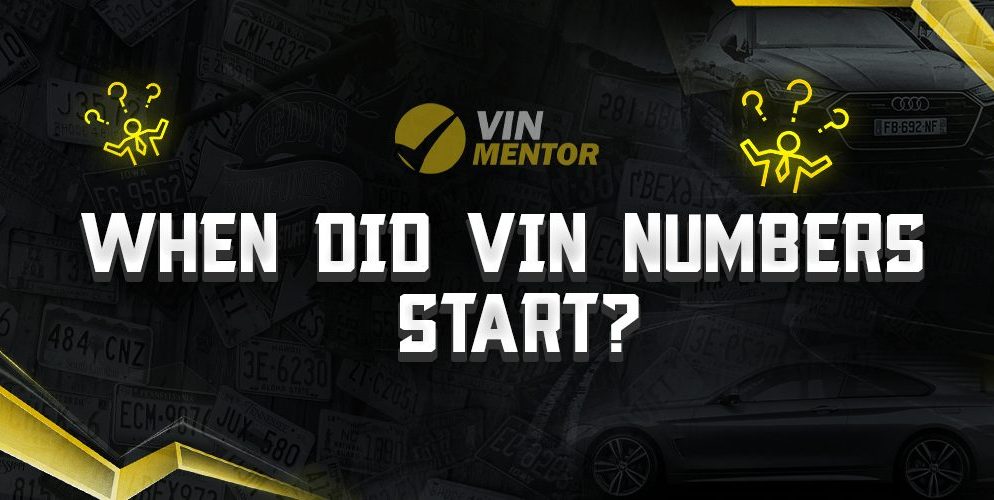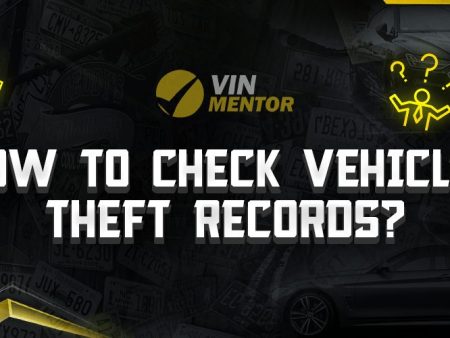

In the US, every contemporary car is recognized by a unique identification code known as a Vehicle Identification Number, or VIN. Just like a fingerprint, each VIN is distinct from one another, enabling accurate identification and differentiation between vehicles. VINs are mainly employed for purposes such as registration, insurance, recalls, financing, service campaigns, and assisting mechanics in ordering the appropriate parts for a particular vehicle.
Manufacturers have been using unique identifiers on vehicles since the early days of mass production. These identifiers, often referred to as “chassis numbers”, help identify specific vehicles and have become more sophisticated over time. Although most people are familiar with the term VIN, not everyone knows when VIN was introduced. So, to learn this, we suggest that you read the following.
Key Takeaways
- At first, VINs were inconsistent and differed based on the manufacturer.
- Between 1954 and 1981, there was no widely recognized uniformity for VINs.
- VINs must not be replicated for a duration of 30 years.
- The European Union has a comparable regulation for VINs, but it is less strict compared to the North American standard.
History of the Vehicle Identification Number
In 1954, American automakers began using sequences of characters to track the cars they made, which were called Vehicle Identification Numbers (VINs). However, during this time, each manufacturer used their own numbering system to create unique IDs for their cars, which meant there was no commonly accepted standard for VINs from 1954 to 1981.
The situation changed in 1969 when the statutory requirement for cars to have visible VINs was introduced. The current 17-character sequence was introduced in 1976 as an expansion of this rule, and it conforms to the standard ISO 3779 developed by the International Organization for Standardization in 1977. This standard specifies the content and structure of a VIN to establish a uniform identification numbering system for road vehicles worldwide.
Standardization
The National Highway Traffic Safety Administration (NHTSA) created a unified VIN system starting in 1981, which required all cars to contain the 17-character VIN. This system was included in the Code of Federal Regulations, Title 49, Chapter V, Part 565. The VIN system applies to motor vehicles, trailers, motorcycles, and mopeds.
In 1987, under the Motor Vehicle Theft Prevention Standard of the Department of Transport manufacturers were required to enter the Vehicle Identification Number (VIN) on specific major parts, such as engines, fenders and hoods, of certain vehicles classified as “high theft”. This was done to keep track of insurance and vehicle history, improve auto recalls and reduce auto thefts. The VIN system ensures that each vehicle has a unique “DNA”- a number, which is not repeated for 30 years.
According to federal law, the VIN must be on a permanent part of the vehicle and is usually located on the left side of the dashboard and can be seen through the windshield from outside the car. The VIN is also stamped on the frame and other places for safety purposes in case of a fire.
The European Union also regulates VINs, but their rules are less strict compared to those of North America. European VINs do not have to include information on the year, factory, or vehicle attributes, although both systems are compatible. Most countries have a VIN system that is compatible with the North American system, but if a car is imported with a VIN system that differs from the ISO 3779 standard, its VIN number must be entered into the MVR database along with enough information to explain what the codes mean.
Conclusion
Although the car VIN did not initially have a single and internationally used system, the standardization of the VIN has created a much more efficient system at global level. VIN can now be used not only to identify a car, but also to buy a used car, getting the information about the car, including the number of previous owners, the date of its last inspection, whether it has been stolen, whether it has gone through any major incidents, such as rolling over or being submerged in water, whether the car’s odometer has ever been rolled back or flipped. So if you want to buy a car, you can easily use the VIN check choosing from our recommended best VIN check websites.
FAQ
Why did car manufacturers start using VINs?
Car manufacturers began using VINs as a way to uniquely identify individual vehicles and to keep track of information such as ownership, registration, and insurance. The use of VINs has also helped with auto recalls, theft prevention, and ordering the appropriate parts for a specific vehicle.
When was the current 17-character VIN sequence introduced?
The current 17-character VIN sequence was introduced in 1976 as an expansion of the statutory requirement for visible VINs that was introduced in 1969. The 17-character VIN conforms to the standard ISO 3779, which was developed by the International Organization for Standardization in 1977.
What is the National Highway Traffic Safety Administration (NHTSA)?
The National Highway Traffic Safety Administration (NHTSA) is a federal agency within the U.S. Department of Transportation that is responsible for promoting safety on America’s roads and highways. The NHTSA created a unified VIN system in 1981, which required all cars to contain the 17-character VIN.
Why is it important to have a standard VIN system?
Having a standard VIN system helps to establish a uniform identification numbering system for road vehicles worldwide. This can make it easier to identify a vehicle’s history, ownership, and other important information. It also helps to reduce auto thefts and improve auto recalls.
How can I use a VIN check to get information about a car?
You can use a VIN check to get information about a car by entering the VIN number into a VIN check website. This can provide you with information such as the number of previous owners, the date of its last inspection, whether it has been stolen, and whether the car’s odometer has ever been rolled back or flipped.












